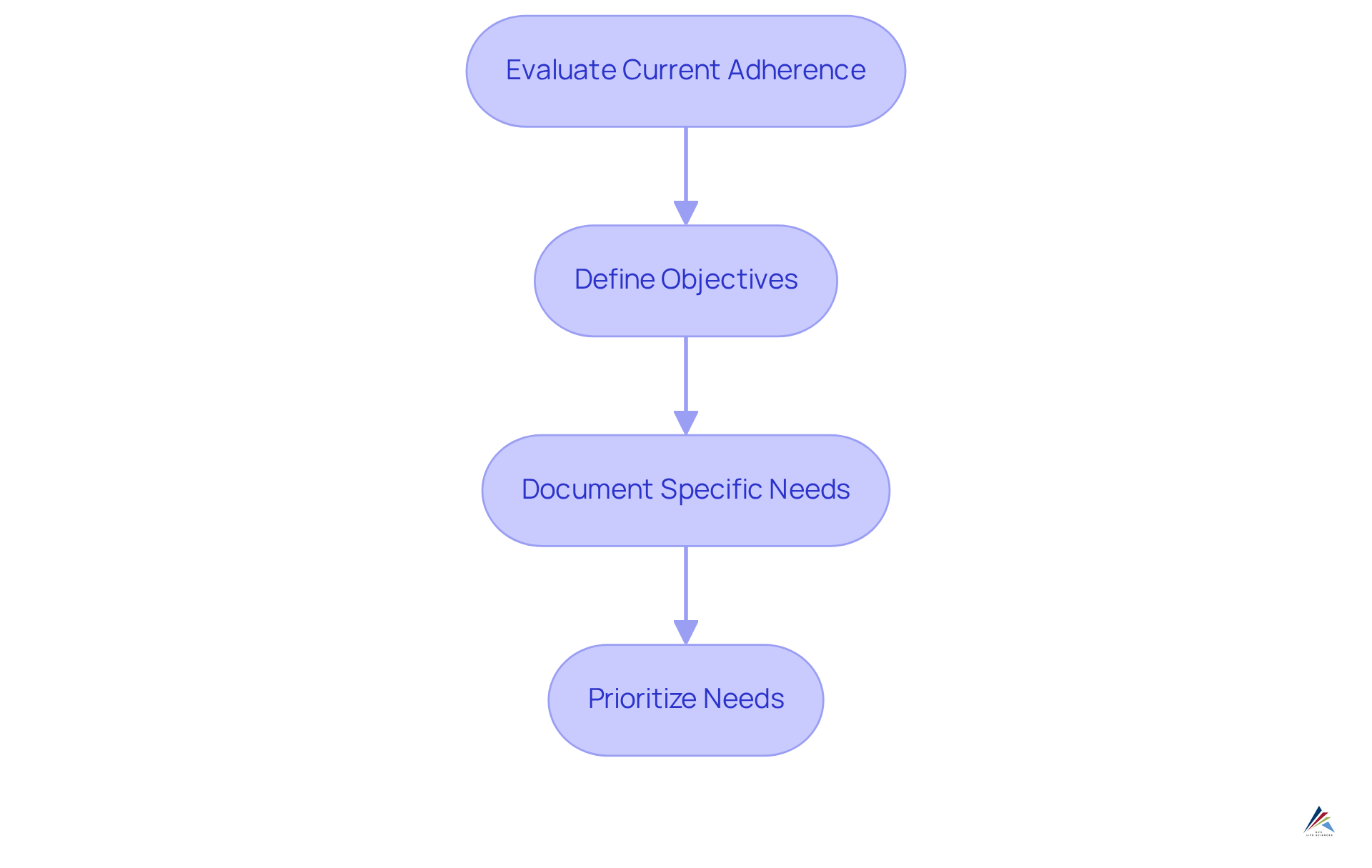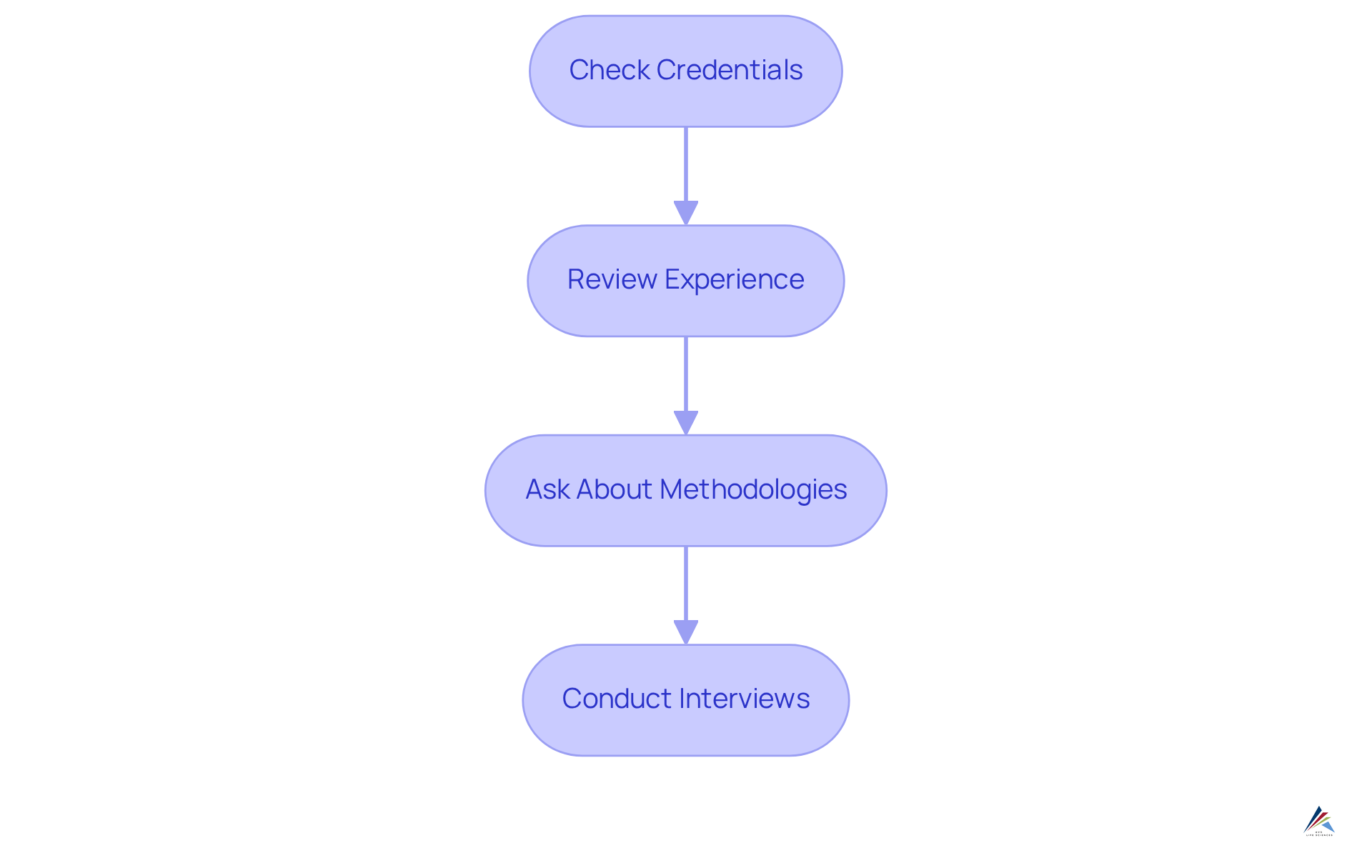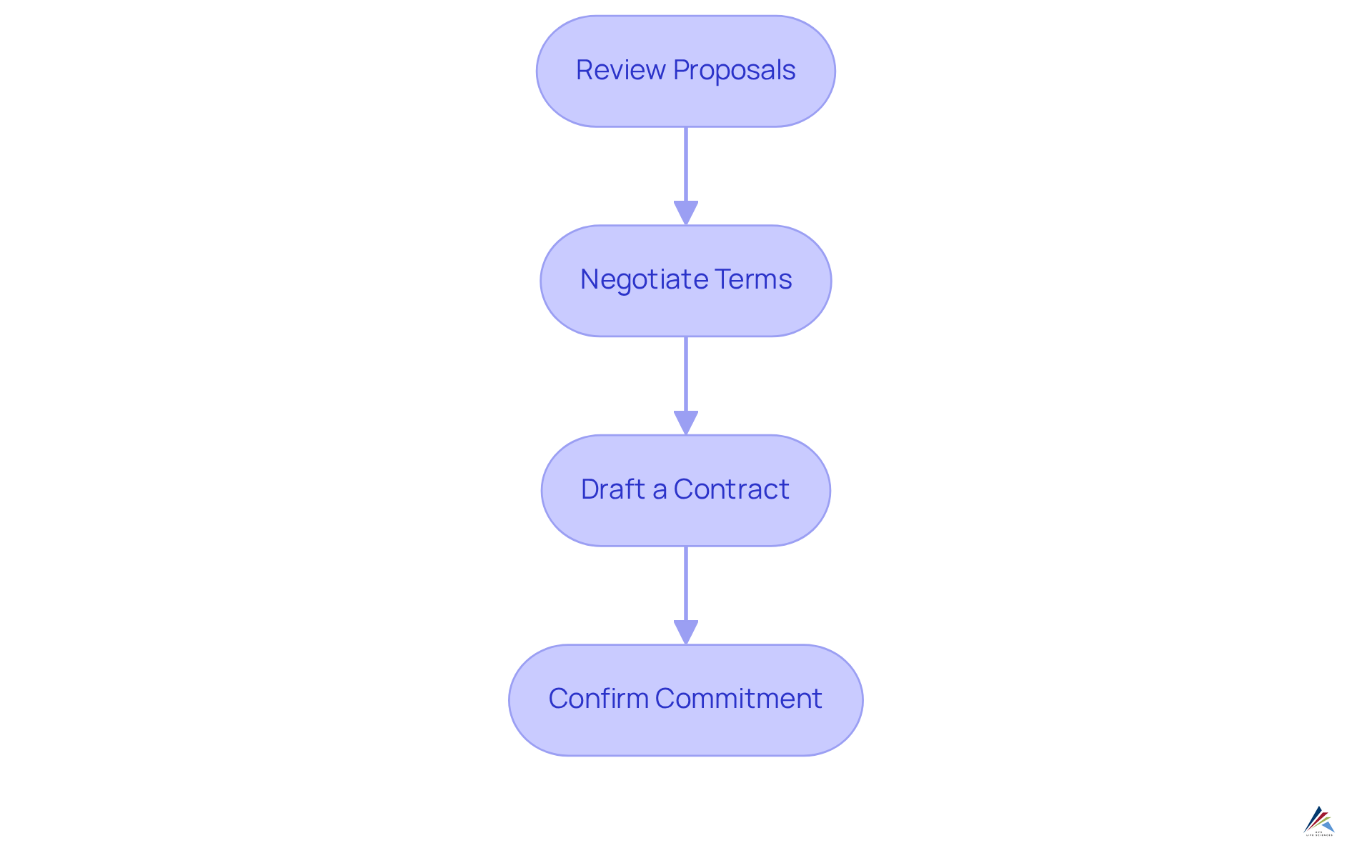4 Steps to Choose the Right Regulatory Consultant

Overview
Choosing the right regulatory consultant involves four essential steps:
- Identify your regulatory needs and objectives.
- Evaluate the qualifications and experience of potential consultants.
- Establish clear communication and collaboration expectations.
- Finalize your selection with well-defined engagement terms.
Each of these steps is crucial, as they collectively ensure a thorough and effective selection process that aligns seamlessly with your organization's regulatory requirements. For instance, assessing your current compliance status and defining specific objectives are actions that not only clarify your needs but also enhance the overall effectiveness of your consultant selection.
Introduction
Navigating the intricate landscape of regulatory compliance presents a formidable challenge for businesses across diverse industries. Selecting the appropriate regulatory consultant transcends merely identifying an expert; it necessitates a strategic approach to ensure alignment with specific compliance needs and objectives.
What are the essential steps to pinpoint a consultant who not only possesses the requisite qualifications but also cultivates effective communication and collaboration?
This guide delineates a systematic process designed to empower organizations in making informed decisions, ultimately bolstering their compliance efforts and mitigating regulatory risks.
Identify Your Regulatory Needs and Objectives
To initiate the process of selecting a regulatory consultant, it is essential to first identify your specific requirements and objectives. Begin with an internal evaluation of your current adherence status and the regulatory challenges you face. Follow these steps:
- Evaluate Current Adherence: Assess your existing adherence frameworks against pertinent regulations such as Good Manufacturing Practices (GMP), ISO standards, and Quality System Regulations (QSR). Recent data indicates that approximately 35% of companies are facing gaps in GMP adherence, underscoring the importance of this step.
- Define Objectives: Clearly articulate what you aim to achieve with the consultant's assistance. This may involve , preparing for audits, or navigating complex regulatory submissions.
- Document Specific Needs: Compile a list of specific services you require, such as quality assurance, guidance on regulatory submissions, or training programs. This will facilitate effective communication with potential advisors.
- Prioritize Needs: Organize your needs according to urgency and significance to ensure that the professional you choose can address your most pressing challenges first.
By undertaking these steps, you will gain a comprehensive understanding of your compliance environment, which will inform the subsequent stages of the selection process.

Evaluate Consultant Qualifications and Experience
Once you have determined your compliance requirements, the next step is to assess the qualifications and experience of potential advisors. Follow these guidelines:
- Check Credentials: Look for certifications pertinent to compliance, such as Certified Quality Auditor (CQA), Certified Pharmaceutical GMP Professional (CPGP), or Certification in Affairs (RAC). These credentials indicate a level of expertise and commitment to the field.
- Review Experience: Evaluate the expert's experience in your specific industry (pharmaceutical, biotechnology, etc.). Look for case studies or testimonials that demonstrate their success in similar projects. Consider insights from case studies like "Navigating FDA Feedback During the 510(k) Review Process," which highlight the importance of effective communication with regulatory bodies.
- Ask About Methodologies: Inquire about the expert's approach to compliance and quality assurance. A skilled advisor should possess a structured methodology that aligns with industry best practices.
- Conduct Interviews: Arrange meetings with prospective advisors to discuss their experience and methodology in detail. This will also provide you with an understanding of their interaction style and whether it aligns with your expectations.
By thoroughly assessing qualifications and experience, you can ensure that the consultant you select is well-prepared to tackle your compliance challenges. With over 300 experienced associates globally, available in the field.

Establish Communication and Collaboration Expectations
Effective interaction and collaboration are essential for successful engagements with a regulatory consultant within the regulatory landscape. To establish these expectations, consider the following strategies:
- Define Interaction Channels: Identify the primary methods of exchange—such as email, phone, or video calls—and ensure both parties are comfortable using them. This clarity streamlines interactions and mitigates potential misunderstandings.
- Set Regular Check-Ins: Schedule consistent meetings to review progress, address challenges, and share updates. Research indicates that regular check-ins can significantly enhance project success rates, keeping all stakeholders aligned and allowing for timely adjustments to the project plan. Notably, companies prioritizing interaction are 25% more productive, underscoring the significance of this strategy.
- Clarify Roles and Responsibilities: Clearly delineate the roles of your team and the consultant. This clarity prevents misunderstandings and fosters accountability, ensuring that everyone understands their specific contributions to the project.
- Encourage Open Dialogue: Create an environment where both parties feel comfortable sharing feedback and concerns. Transparent dialogue promotes effective problem-solving and , ultimately resulting in improved project outcomes. As Patrick Lencioni noted, "Teamwork begins by building trust," which is crucial for successful collaboration.
By applying these interaction and collaboration strategies, you can cultivate a productive working relationship that greatly enhances the likelihood of project success. Various studies indicate that effective collaboration not only improves project execution but also strengthens partnerships, making it a cornerstone of successful regulatory consulting. Furthermore, AVS Life Sciences' extensive experience and an 80% repeat business rate underscore the effectiveness of these strategies in achieving successful outcomes.

Finalize Your Selection and Set Clear Engagement Terms
After assessing potential advisors and establishing communication expectations, it is crucial to finalize your choice and set clear engagement terms. Follow these steps:
- Review Proposals: Carefully assess the proposals submitted by your selected advisors to ensure alignment with your specific needs and objectives. Seek clarity in their methods and how they intend to tackle your compliance challenges.
- Negotiate Terms: Engage in discussions to negotiate the terms of engagement, focusing on the scope of work, timelines, deliverables, and payment structures. According to industry data, common terms included in consulting contracts often encompass confidentiality clauses, performance metrics, and conditions for termination. Ensure that both parties have a mutual understanding of expectations to avoid future disputes.
- Draft a Contract: Develop a formal contract that encapsulates all agreed-upon terms. This document should clearly outline the , including any legal considerations that may arise during the engagement. A well-organized agreement acts as protection for both the advisor and your organization.
- Confirm Commitment: After signing the contract, confirm the commitment from both sides to adhere to the agreed terms. This step is vital in establishing a professional tone for the engagement and fostering a collaborative relationship.
By finalizing your selection and setting clear engagement terms, you ensure that both you and the regulatory consultant are aligned, paving the way for a successful partnership that meets your regulatory compliance needs.

Conclusion
Selecting the right regulatory consultant is an essential step for any organization aiming to meet compliance standards and navigate complex regulatory landscapes. By thoroughly understanding your regulatory needs and objectives, evaluating potential consultants' qualifications and experience, establishing clear communication expectations, and finalizing engagement terms, businesses can strategically position themselves for success in their compliance efforts.
This article outlines a systematic approach to the selection process, emphasizing the importance of identifying specific compliance requirements, assessing consultants' credentials, and fostering open dialogue throughout the engagement. Each step is meticulously designed to ensure that organizations not only choose the right consultant but also cultivate a productive working relationship that enhances project outcomes.
Regular check-ins, clarity in roles, and well-defined contracts are crucial to preventing misunderstandings and ensuring smooth collaboration.
Ultimately, the process of choosing a regulatory consultant should be approached with careful consideration and strategic planning. Organizations are strongly encouraged to invest time and resources into this selection process, as the right consultant can significantly influence compliance success and overall operational efficiency. By prioritizing effective collaboration and communication, businesses can facilitate smoother engagements and empower themselves to achieve their regulatory objectives with unwavering confidence.
Frequently Asked Questions
What is the first step in selecting a regulatory consultant?
The first step is to identify your specific requirements and objectives by conducting an internal evaluation of your current adherence status and the regulatory challenges you face.
How can I evaluate my current adherence to regulations?
You can assess your existing adherence frameworks against pertinent regulations such as Good Manufacturing Practices (GMP), ISO standards, and Quality System Regulations (QSR). It is noted that approximately 35% of companies are facing gaps in GMP adherence.
What should I define when seeking a regulatory consultant?
You should clearly articulate your objectives, which may include enhancing compliance, preparing for audits, or navigating complex regulatory submissions.
What specific needs should I document when selecting a consultant?
Compile a list of specific services you require, such as quality assurance, guidance on regulatory submissions, or training programs, to facilitate effective communication with potential advisors.
How should I prioritize my needs when selecting a regulatory consultant?
Organize your needs according to urgency and significance to ensure that the consultant you choose can address your most pressing challenges first.
Why is it important to understand my compliance environment before selecting a consultant?
Gaining a comprehensive understanding of your compliance environment will inform the subsequent stages of the selection process, ensuring that you choose the right professional for your needs.
